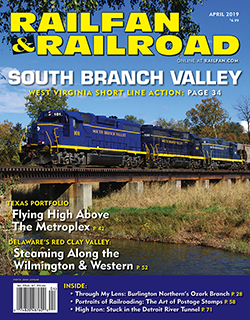 Colleague Kevin P. Keefe is a wonderful friend and has about as much enthusiasm for railroads as do I. You may have seen a link to one of his weekly blogs posted on the various forums of social media. In mid-February, Kevin wrote about our longtime mutual friend, author David P. Morgan. The column took me back to eras long ago, beginning when Morgan was the young son of a preacher in Monticello, Ga.
Colleague Kevin P. Keefe is a wonderful friend and has about as much enthusiasm for railroads as do I. You may have seen a link to one of his weekly blogs posted on the various forums of social media. In mid-February, Kevin wrote about our longtime mutual friend, author David P. Morgan. The column took me back to eras long ago, beginning when Morgan was the young son of a preacher in Monticello, Ga.
Morgan’s life in Monticello was the one era I knew nothing about. In later years, Morgan and I talked at length about his life as a young railfan in Louisville, Ky., leading up to his era as the longest-serving editor of Trains magazine. Therefore, I gave a careful read to Kevin’s entry. The one thing I did not get from the blog was something I guess I will never know — how did Morgan become such a talented writer?
My guess is some people are simply born with talent. Morgan wrote with such grace that he created a whole generation of prolific railfan writers. Ask anyone now at his old magazine; they believe it would have gone out of business decades ago without Morgan’s talent. Of course, the publication thrived for decades after, through Kevin himself as editor.
I got together with Morgan at least once a year or more. We would go to his favorite bar and drink the night away. As the night went on, we (Morgan, his wife, and I) would laugh so much our sides hurt. I seem to remember Morgan drank Seagram’s VO straight, although my memory has faded with the years, and I drank Wild Turkey bourbon, occasionally with ice. I couldn’t keep up with Morgan, so I tried to hold down the volume of my drinking. If I forgot, my headache would remind me the next day. Morgan didn’t drink during the day. He also didn’t talk much when sober.
It was impossible to see Morgan’s talent unless one stood behind him to watch him work on his old manual typewriter. That was back when Trains was located in downtown Milwaukee at 1027 North Seventh Street.
Morgan was not a photographer, but he was an excellent judge of photographic talent, even when the photographer didn’t know he was talented. I remember once Morgan used one of my black & white photographs spread over two full pages. It was a photograph I almost didn’t send him. It was a switch engine ambling along on 10-mph track so overgrown that one could not see the track. The engine, with one car and a caboose, was backlit and it appeared to be swimming through tall grass. Wow. Morgan saw my talent. I didn’t. Morgan had a way of developing new talent by giving photographers a way to exhibit their work and create images specifically suited to the editorial needs of the magazine. I think Morgan didn’t take photos himself because it would screw up his eye for spotting new contributors.
This will surprise most of you, but Morgan once offered me a job at Trains as managing editor. We were chatting one evening on the platform of the Southern Railway station at Salisbury, N.C., at the end of the first day of a fan trip, leaning on an old baggage wagon, when he surprised me with the offer. I was stunned. I told him I needed some time to think about it. Such a move would totally upset my life’s plan to spend my professional years in Washington. I would have to pull up roots and head for a totally different life in Milwaukee. Perhaps one year I would have been editor of Trains. I know that staying in Washington turned out to be pretty good, and I’m glad I did it. But I can’t help wondering how different life would be now. Would I have been promoted to editor when Morgan left? Would I have spent decades becoming the new Morgan? Who knows?
I can’t write about Morgan without mentioning the best story he ever wrote, “The Mohawk That Refused to Abdicate.” Eventually it became a book called The Mohawk That Refused to Abdicate and Other Tales (Kalmbach Books, 1975). If you can possibly find a copy, get it. Morgan and his photographer friend Phil Hastings spent years bumming around the country in search of the last operational steam locomotives in the mid-1950s.
I cannot mention “The Mohawk That Refused to Abdicate” without giving you at least a small look at what he wrote. This brief passage is enough to raise goosebumps. This is the story of a New York Central 4-8-2 Mohawk heading up to Cleveland with a “junk freight” of bad order cars and various other equipment that needed to go to the scrap yard or undergo extensive repairs. Morgan and Hastings ran into Mohawk 3005 at Galion, Ohio, where the crew was putting its train together. The engineer was, as Hastings put it, “an alert and brawny man whose goggles and rakish mustache suggested a flair for making cinders fly.” Morgan asked the engineer how fast he would move when he left town. The engineer replied 60 mph. “With this train?” Morgan asked. The engineer replied, “Oh yes, we’ll ride once we get out of here.” Morgan scoffed under his breath.
Finding nothing else in steam at Galion, Morgan and Hastings moved 13 miles closer to Cleveland at Shelby, Ohio, where a Baltimore & Ohio branch line crossed the double-track NYC main line. The tower operator at Shelby agreed with Morgan’s skepticism. Besides, the 3005 had pulled a drawbar leaving Galion, turning the line into single track with four passenger trains in the area. Stepping outside, Morgan and Hastings heard a whistle in the distance. Scanning the timetable for a passenger train, suddenly there was a closer whistle.
“Why, it’s the extra! Can’t be — he might just have — it is and he’s rolling! Rolling is mild language for what he was doing. Extra 3005 … was bearing down on Shelby with all the implications of destiny in the Book of Revelation, gaining momentum with each revolution of those four pairs of 69-inch drivers, making the legal mile a minute with ease, and perhaps a notch or two better. The elephant-eared aristocrat of an Alco rammed across the diamond with smoke going high, the Baker up near center, and the crew enjoying the breeze. Out of her dusty wake came her train — rattling, rocking, rolling, riding to Cleveland.
“Wonderful! Too often, steam departs from us in the form of a fan trip that suffers an engine breakdown … or in a line of dead power nursed to the junkers by a Geep … or as a local freight locomotive wheezing out of town without ceremony or drama. How much better to wind up like the 3005, taking a quiet Ohio town apart, pinning its ears back, performing like Alco said her 4,410-cylinder horsepower should perform.”
—DON PHILLIPS is a veteran newspaper reporter and a magazine columnist writing about railroads and transportation policy for more than 40 years.



